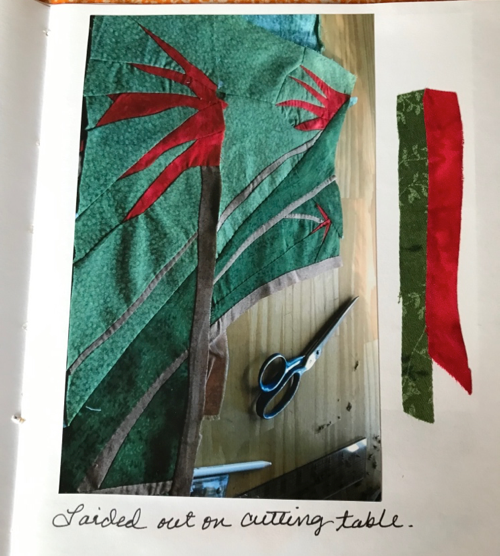An Artist of Quilts

Linda Walmsley’s quilt The Road to Rock Hall. Photo by the artist.
Linda Walmsley was always an artist — from the time she was a little child. She had her first art classes in middle school in Detroit, Mich., where she grew up. Then in high school her teachers invited her to spend her Saturdays taking more classes. She ultimately studied at the Detroit Art Institute and Wayne State University.
Walmsley remembers that she loved sitting in the Diego Rivera Room at the Wayne State University Museum. His murals and frescoes were painted on the walls and Rivera had put wonderful things in the nooks and crannies all around the room. She reveled in all the colors, shapes, and imagery.
She majored in sculpture but did not continue it, preferring to paint and draw. She moved to the Eastern Shore when she was 29, first living in Betterton, and then Chestertown, where she has resided ever since. Like many, she thought this was just a stop on the way elsewhere, probably D.C., but she met Austin Walsmley, married him, and had two children.
After her children, Julie and Chris, were born, Walmsley decided to try quilting. She started by making her own patterns and designs. Her daughter Julie was part of a middle school Ecology Group and Walmsley was inspired to make little quilted landscapes for them as prizes they could raffle off to fund their environmental projects.
She kept on designing quilts. She said she had to do something with her hands during all those PTA meetings!
Walmsley started with geometric patterns, but now she mostly makes landscapes, where she can play with the negatives and the positives. She likes to design quilts with reflections in the water.

The artist, Linda Walmsley, and her quilt Winslow Park, Maine. Photo by the author.
Walmsley liked the Maine blueberries fabric. In fact, hunting for fabrics is part of her enjoyment. She has hit every fabric store she could here and in Maine, where her daughter and family live currently. There are many specialty shops in Maine for fabrics.

Cottage on Lake Sinclair, Canada. Photo by the artist.
This quilt is autobiographical. It shows her as a little girl in a swing. In the background is the garage with an upstairs dorm where she slept, often with several cousins. There were 6 or 7 seven iron cots for them. It was a wonderful place for a kid. The adults had their separate cottage. The quilt shows the red maple leaves of Canada.

The artist and Fall in Harpswill, Maine. Photo by the author.
The quilt Fall in Harpswill, Maine displays the red sumac leaves in the Fall.
Linda has kept a little book — with a fabric cover, of course, — of sketches, photos, and fabric samples that document the process of the creation of each of her quilts. She starts with a sketch. Then comes the fun of finding fabrics for each piece. She makes a full-size pattern, often revising her first sketch, and attaches a bit of fabric to each piece. And so it grows.

Fabric book cover. Photo by the author.

Initial sketch. Photo by the author.
The next major step is to cut apart the pattern in order to trace the shape on the fabric and cut each piece with a seam allowance. She just does little sections at a time, usually starting in a corner or an edge, or maybe somewhere where it is complicated and demanding. She starts sewing them together — all on her lap. No frame for Walmsley! She puts together the quilt and the backing with safety pins — many, many safety pins. The result is kind of puffy, but that is its charm.

Cutting out pieces. Photo by the author.

Starting to piece. Photo by the author.
Her least favorite part is cutting out all the pieces of fabric, but the most satisfaction comes with the quilting when she can see the result.

Quilting with safety pins. Photo by the author.
Walmsley has a collection of 15 or 20 quilts. Some became gifts for her children and grandchildren, though these are not for covering beds. No romping on these beautiful puffy landscapes!
Many of her quilts are of Rosin Creek (Chester Harbor, Queen Anne’s County) where she has lived for many years. It is a very pretty place with many different moods and lots of reflections in the water.

Rosin Creek. Photo by the artist.
Walmsley’s next quilt is quietly taking shape in her mind — no sketch just yet. Recently three close friends have died, and she wants to memorialize them in a quilt. She’s thinking of empty chairs — probably in a room, but maybe not. Her process is just beginning.
Jeanette E. Sherbondy is a retired anthropology professor from Washington College and has lived here since 1986. In retirement she has been active with the Kent County Historical Society and Sumner Hall, one of the organizers of Legacy Day, and helped get highway /historical markers recognizing Henry Highland Garnet. She published an article on her ethnohistorical research of the free Black village, Morgnec.
Common Sense for the Eastern Shore







